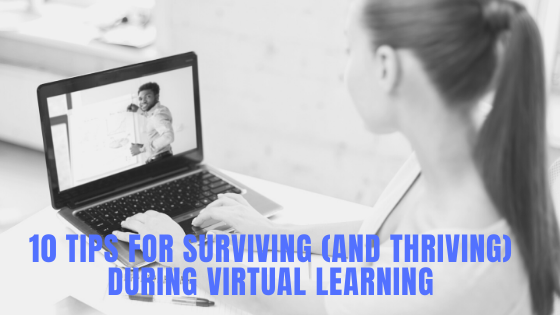
The coronavirus pandemic has thrust teachers into the world of virtual teaching and learning, forcing them to find ways to connect and support students without the presence of a physical classroom. We have the privilege of working with some of the most committed and innovative educators out there, so we surveyed the EdIncites community and asked them to share their best tips and tricks for surviving (and thriving) during remote teaching and learning. We were blown away by the responses, and it became evident that teachers truly are some of the most creative, kind-hearted and adaptable humans out there. From the hundreds of responses we received, here are the top 10 tips for remote teaching and learning:
#1: Lean on others for support
“The best advice I can give to others about teaching virtually is to work with others. Share ideas and don’t be afraid to ask questions. We are all going through this, and we need to carry each other.” – Cathy Romick, Choir Teacher, Dayton Public Schools
#2: Listen (and let them know you hear them!)
“I think the best thing I have learned is to listen. I have found that often during this crisis, students need someone to listen even more than they need help with their schoolwork. They are in a new age of learning that is not natural for them. I teach middle school students who are very social. They are missing that social interaction. One thing I have done is institute “Fun Fridays”. Every Friday, we play a game or do a fun activity over Google Meets. Since I started this, more students are showing up for lessons during the week and encouraging friends to join us on Fridays. It has been a game changer.” – Monica Turner, Wright Brothers Middle School
#3: Get creative with incentives
“The best tip I have is to reward them! I’ve done this by sending them surprises in the mail and writing them notes! I’ve offered $5 gift cards by entering their names in a drawing for completed work. I’m just trying to keep the normal routine as if we were in school! They love rewards!” – Michelle Pund, 2nd Grade Teacher, Eastmont Elementary
#4: Find new ways to connect…and be persistent
“One of the best tips I would pass on pertains to working with high school students. I found the best way to reach the student is to ask the parent for more than one phone number to use when the Chromebook connection is not effective. Having three or four cell numbers, including the student’s cell, helped me to reach the student in the middle of the day when they were not replying to emails. During this crisis, some students are working long hours at their jobs to provide food for their families and may not be as available during school hours. Parents appreciate the flexibility in our willingness to try different ways to connect with their child. Also, using a google voice number gives us the added level of protection to maintain professionalism.” – Mary Ivan, Intervention Specialist, Meadowdale High School“The most effective advice I’ve received when online teaching is to engage students personally. Send personalized, individual messages, inquire about their lives outside of school, talk about their mental/emotional health, etc… This keeps my students motivated to do our virtual lessons!” – Elizabeth Hutchison, French Teacher, Osborne High School
#5: Stay (digitally) organized
“The best tip I’ve learned is that digital organization is even more important than physical organization. My district uses Office 365, so I’ve been able to use One Drive and Forms to organize my students’ assignments and eliminate the problem of having assignments getting lost because they came in from various channels.” – Whitney Chandler, Language Arts Teacher, McEachern High School“The best tip I have for virtual learning is when working with younger children to keep your resources in one place. Easy for them and their parents to get to each day. If you change where they have to go every day you will lose them just like in the classroom. Consistency and routine are just as important in the virtual world to these little minds.” – Amy Trembley, Murdock Elementary School
#6: Prioritize yourself and remember balance
“The best tip I have for educators trying to manage this new and hectic time is to remember to take time for yourself. It is so hard to get lost behind the computer screen and forget to take of the number one person…YOU! Take care of yourself, do one thing for yourself a day, and remember to breathe! We’ve got this.” – Stephanie Ray, 5th Grade Teacher, Shallowford Falls Elementary“Set a structured schedule for yourself! Assigning every type of a task a time in the day has kept my mind at peace and allowed my day to stay organized without missing a parent distress call or a student zoom meeting.” – Phil Buben, Teacher, CCSD
#7: Make lessons fun…and find ways to take them offline
“The best tip/trick for digital learning I have found is creating or using at least one hands-on lab each week for students to do using materials you find around the house. Then, the students submit a photo of their experiment and data analysis via FORMS on Office 365 or video responses on Flipgrid. I teach both 6th grade (Earth Science) and 8th grade (Physical Science) so it has been a challenge to keep the students interested and having fun with the science curriculum. This technique of “virtual labs” has enabled my students to continue learning in a hands-on way since we are unable to do face-to-face labs in the classroom, and Office 365 makes it so easy for me to grade what they submit! My 6th graders have done an outdoor scavenger hunt on Weathering, Erosion, & Deposition and a Weathering Erosion Lab with Skittles. My 8th graders have made parachutes to safely land an egg while learning about gravity & air resistance and they learned how to balance objects (making a tower out of homemade objects) when we were studying forces.” – Elizabeth Crumpton, Science Teacher, Palmer Middle School
#8: Remember your audience
“Best tip: keep the lesson short because kids’ attention spans aren’t that long and neither are the parents’ patience”. -Rickey Smith, Teacher, CCSD
#9: Consider inequalities in accessibility
“The best tip/trick I have learned is to not assume anything…you have no idea what life is like at home for students. They could be trying to do their work on a tiny phone screen. They could be sitting in a McDonalds parking lot because they do not have WIFI. Be there for your students, and don’t give them deadlines that they may not be able to meet due to life.” -Shannon Ventresca, 6-8 Science Teacher, East Cobb Middle School”
#10: Embrace change
“The best tip was to just dig in and embrace all of the new technology that you may or may not have been able to experience before….settle in to new ways of teaching and love your children through video chatting! I feel closer than ever and have communicated with my families more often through this uncommon time of teaching. Truly an imaginative time to express yourself as a teacher in unique ways! Stay in touch with your children and keep those bonds strong. We can continue to grow our brains every day creatively!” – Laurie Mendenhall, Gifted Specialist, Varner Elementary School
And one more for good measure, courtesy of Anna Helms, Elementary Art Teacher with Kemp PreK-6 School, “Don’t sit next to the candy bowl!”
On a more serious note, these are truly unprecedented times, and we are all grateful to the teachers who have stepped up and been a bright spot during a challenging season. Which of these tips is your favorite? What has helped you maintain sanity and support your students during this time. Let us know in the comments!



